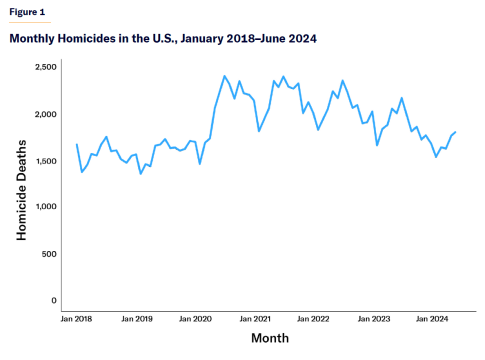Surge in U.S. Homicides: A Closer Look at 2020-2021 Trends
Study Highlights Escalation Driven by Unique Circumstances
A comprehensive study from the Manhattan Institute indicates that the United States witnessed an unprecedented rise in homicide rates during the peak of the COVID-19 pandemic and civil unrest from 2020 to 2021. The analysis covers 78 large cities, revealing troubling insights into the intertwining factors influencing this crime wave. With a 30% spike in homicides in 2020—the largest single-year increase in over a century—efforts to unpack this phenomenon are urgent.
Key Findings on Local Trends
The study categorized the homicide trends into three distinct phases:
- Baseline (2018–2019)
- Spike (2020–2021)
- Recovery (2022–2023)
Cities grappling with high pre-existing violence levels saw the most dramatic increases in homicides. Significant factors contributing to this escalation include:
- Reduced policing due to staffing shortages and widespread anti-police protests.
- Disrupted public services linked to the pandemic.
- Concentrated group-related violence, particularly in areas with established gang activity.
Notably, while traditional assumptions correlate unemployment with crime rates, the study reveals that shifts in unemployment during the pandemic did not predict increases in homicides, indicating complex underlying dynamics.
Diverse Recovery Patterns
While some cities, like St. Louis and Miami, showcased effective recovery by reverting near pre-spike levels, others like Cleveland and Milwaukee lagged behind, highlighting that cities with high baseline homicide rates often face more prolonged challenges. The study underscores the critical nuance in assessing these cities’ trajectories, as differing law enforcement tactics and community resilience played pivotal roles in shaping outcomes.
Anomalies: The Cases of Portland and Baltimore
The contrasting experiences of Portland and Baltimore serve as notable case studies. Portland, starting with a lower baseline, experienced a dramatic rise in its homicide rate attributed to gang-related violence, compounded by significant cuts to police funding. Conversely, Baltimore, despite historically high crime rates, exhibited relative stability during this period, likely due to effective community-police relationships fostered by reforms initiated after civil unrest in 2015.
Conclusion: Re-evaluating Crime Forecasts
The findings from the Manhattan Institute challenge widely held assumptions about crime causation, emphasizing the need for a nuanced approach to public safety strategies. Policymakers are urged to consider a blend of proactive policing and community engagement to better manage future crises and mitigate violence.
As cities seek effective pathways to recovery and security, understanding the multi-faceted reasons behind these sharp increases in violence can drive vital changes within law enforcement and community relations.
Developing updates will continue to shed light on these urban violence trends and the responses aimed at restoring safety.

Focuses on crime, public safety, and regional events.
Bio: Marcus is a community-based journalist passionate about reporting impactful stories that matter most to readers.

